
Features
Research
Active Isolated Stretch For The Client
Affecting positive change in the lives of our clients is what it’s all about, so let’s put them in the best hands possible – their own!
October 1, 2009 By Paul Elliott RMT
Affecting positive change in the lives of our clients is what it’s all about, so let’s put them in the best hands possible – their own!
 In my last segment on Active Isolated Stretching, I suggested that stretching is more effective when we apply the “2-Second rule.” This 2-Second rule contradicts everything we have been taught about stretching in the past 60 years.
In my last segment on Active Isolated Stretching, I suggested that stretching is more effective when we apply the “2-Second rule.” This 2-Second rule contradicts everything we have been taught about stretching in the past 60 years.
To briefly summarize:
The Mattes Method enables maximum myofascial stretching because the muscle is stretched and released without activating the myotatic reflex which, after two seconds, inhibits the stretch potential of a muscle.
“A prolonged static stretch, greater than five seconds actually decreases the blood flow within the tissue, creating localized ischemia and lactic acid build up. This can result in irritation or injury of muscular, tendonous, lymphatic and neural tissues, similar to the effects of trauma and overuse syndromes.”1
Sherrington’s Law states that a muscle will do one of two things, it will contract or it will release. Therefore, by actively contracting an agonist muscle group, a
neurological message is sent to the antagonist muscles to release.
The body responds to inappropriate tension by recruiting the antagonists (opposite side muscle groups) and in doing so deters the stretched muscle from any potential injury.
Active Isolated Stretching can expand the potential of any body. Active Isolated Stretching can be used by people of all walks of life. It was Aaron Mattes’ desire to
create a series of protocols that would be used by people of any age for either prevention or part of a rehabilitation process or to improve their physical condition.
Most client presentations will not be resolved in their first visit.
Many treatments may be required to bring about the change you have planned. By teaching the client a method of self-help techniques they will gain a working tool they can use to participate in their own well-being – advancing their recovery and enhancing their own quality of life. By joining forces with the client, you are bringing together two life energies; one being the client’s need for help, the other being the therapist’s goal to help.
With that said, I consider Active Isolated Stretching as a tool for life; a technique that the client can use whenever they need to.
Health, as defined by a body, is the absence of disease. Health as defined by a client in pain is usually a matter of simply feeling not-in-pain.
One of the greatest contributors to pain is ischemia; (the lack of blood flow to a tissue) oxygen and nutrition are prevented from reaching an inflamed region. Left unattended, these areas will continue to report pain. Without proper relief or self-help techniques, a client is often guided into a method of pain management.
As a therapist I find that term objectionable. Pain management often means pills or orthotics. Often the client is being conditioned to live with their pain.
When we teach Active Isolated Stretching techniques to a client, suddenly the end of a massage session does not mean the end of the treatment. With AIS as a Life tool, the client can leave their session armed with a very effective self-help method. If they apply this method between sessions (call it homework) they are apt to gain greater freedom of movement. As therapists we often witness the new confidences borne out of liberated and more flexible muscles. Through this level of participation, clients are helping to restore their quality of life, while, at the same time, enhancing the work that you achieved during their treatment.
As a therapist, I find that I can be of greater help to my clients by encouraging them to take ownership of changing the physical restrictions and limitations affecting their health.
You may be the motivator and innovator behind the client’s success, but they will be in the driver’s seat.
Reducing Hand, Wrist, Forearm And Elbow Stress
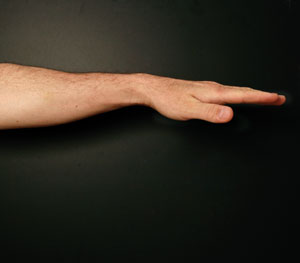 |
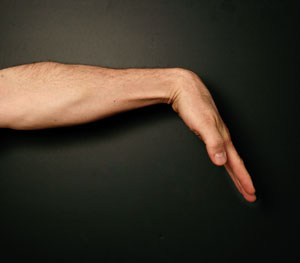 |
| Figure 1
|
Figure 2
|
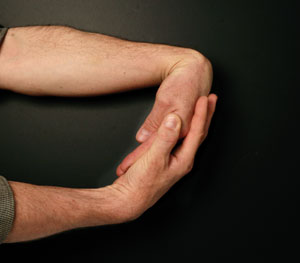 |
 |
| Figure 3 |
Figure 5 |
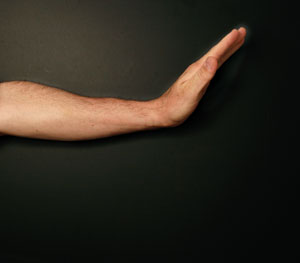 |
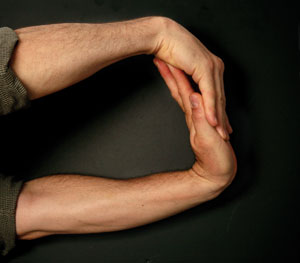 |
| Figure 6 |
Figure 7 |
1. From the neutral position with palm facing downward, elbow extended, begin by inhaling a regular breath
2. Bend the wrist (In AIS-ese): Contract wrist flexor muscles – “agonist” pulling hand to the floor until hand reaches “end movement”
3. Assist by applying a gentle two-second stretch across back of the hand with your opposite hand and breathe out during the stretch.
4. Release and repeat 8 to 10 times
5. From a neutral position withpalm facing downward, elbow extended begin by inhaling a regular breath
6. Extend the wrist backwards, raising the hand backwards as far as possible until your hand reaches its “end movement”
7. Place your free hand over the whole surface of the exercising hand and fingers. Assist the stretch by gently pulling for two-second intervals. Breathe out. Repeat 8-10 times.
8. Inhale while bringing hand back to neutral.
Photography by Andrea Hausmann – www.hausmannphotography.com
Note: It is important to work the muscles you are targeting, (agonist muscles) as well as the opposite group of muscles (antagonist muscles) in both directions. This routine stretches wrist and finger flexors.
Reference
1. Dr Taras Kochno, Active Isolated Stretching – The Mattes Method. Page 1
Print this page